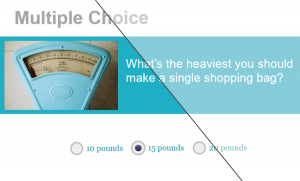E-Learning Myths That Won’t Die
E-learning is an extremely flexible tool for employee development. There are dozens of ways you can tailor your e-learning to different circumstances and audiences. It’s virtually impossible to start an accurate sentence with, “All e-learning.” That’s why some of the myths about e-learning just make me cringe. People forget how easy it is to craft a solution perfect for your situation.
This past week, we thought it would be fun to crowdsource and collect some e-learning myths that just won’t die. So, we asked e-learning folks on the Twittersphere to share their favorite e-learning myths, using the hashtag: #elearningmyths.
Here are three of my favorite e-learning myths, as well as some of my favorites that were shared through Twitter this past week.
Myth: Employees don’t like e-learning.
This one might be true… sometimes. But isn’t it more realistic to think employees don’t like bad e-learning? Employees like having the tools they need to do their jobs. Employees like knowing that the company they work for has a clue about their jobs. They like training that doesn’t talk down to them or insult their intelligence.
Employees like feeling engaged and challenged. So if your e-learning gives people realistic scenarios and relevant information, they’ll appreciate it.
Myth: Interactivity is always the goal.
Interactive e-learning is often a good strategy. But sometimes it’s easy to go overboard in trying to get there. Forcing gamification on a straightforward topic isn’t going to make the experience fun. Similarly, the interactions you include should be meaningful. Although click-to-reveal slides can be used to add interactivity, they don’t require the learner to use their critical thinking skills.
People who are smart can see when a course is wasting their time. If you need the learner to memorize facts, teach to that. Don’t be afraid to use multiple-choice questions when that’s the best solution.
Myth: All good e-learning must be mobile compatible.
It’s true that mobile technology is revolutionizing the web. And it’s becoming more important that public-facing websites work with mobile technology. But e-learning isn’t a website. E-learning needs to work on the platform your learners will use to access the course.
If your LMS isn’t mobile friendly, no one will ever view it on a mobile device. Now, on the other hand, if your learners are accustomed to using their tablets and phones for work, mobile compatibility may be important. There’s no hard-and-fast rule about whether or not your courses need to work on mobile devices. It’s all about knowing your audience.
Don’t let buzzwords like “mobile compatible” or “responsive design” force you to make unnecessary design decision.
Here are some other favorite e-learning myths shared by the folks on Twitter:
E-learning isn’t as effective as classroom training #elearningmyths
— Ashley Chiasson (@amdchiasson) May 3, 2016
Word for word narration of slide text makes the content more memorable #elearningmyths
— Alyssa Gomez (@1alyssagomez) May 3, 2016
Read n click works best for compliance #elearningmyths
— christian lee (@libretraining) May 3, 2016
Online compliance training can’t be interesting and engaging. #elearningmyths
— Melanie Sobie (@sobiemel) May 4, 2016
If you’re a good designer of instructor led training, you’ll be great at designing e-learning. #elearningmyths (it can be pretty different!)
— Rachel Barnum (@OhThatRachel) May 4, 2016
Bullet points always make everything easier to read. #elearningmyths
— Alexander Salas (@StyleLearn) May 4, 2016
#elearning HAS to have next and previous buttons #elearningmyths
— Melissa Milloway (@MelMilloway) May 4, 2016
What e-learning myths have you encountered? Share them with us by commenting below or on Twitter with the hashtag: #elearningmyths.

 Previous Post
Previous Post Next Post
Next Post



